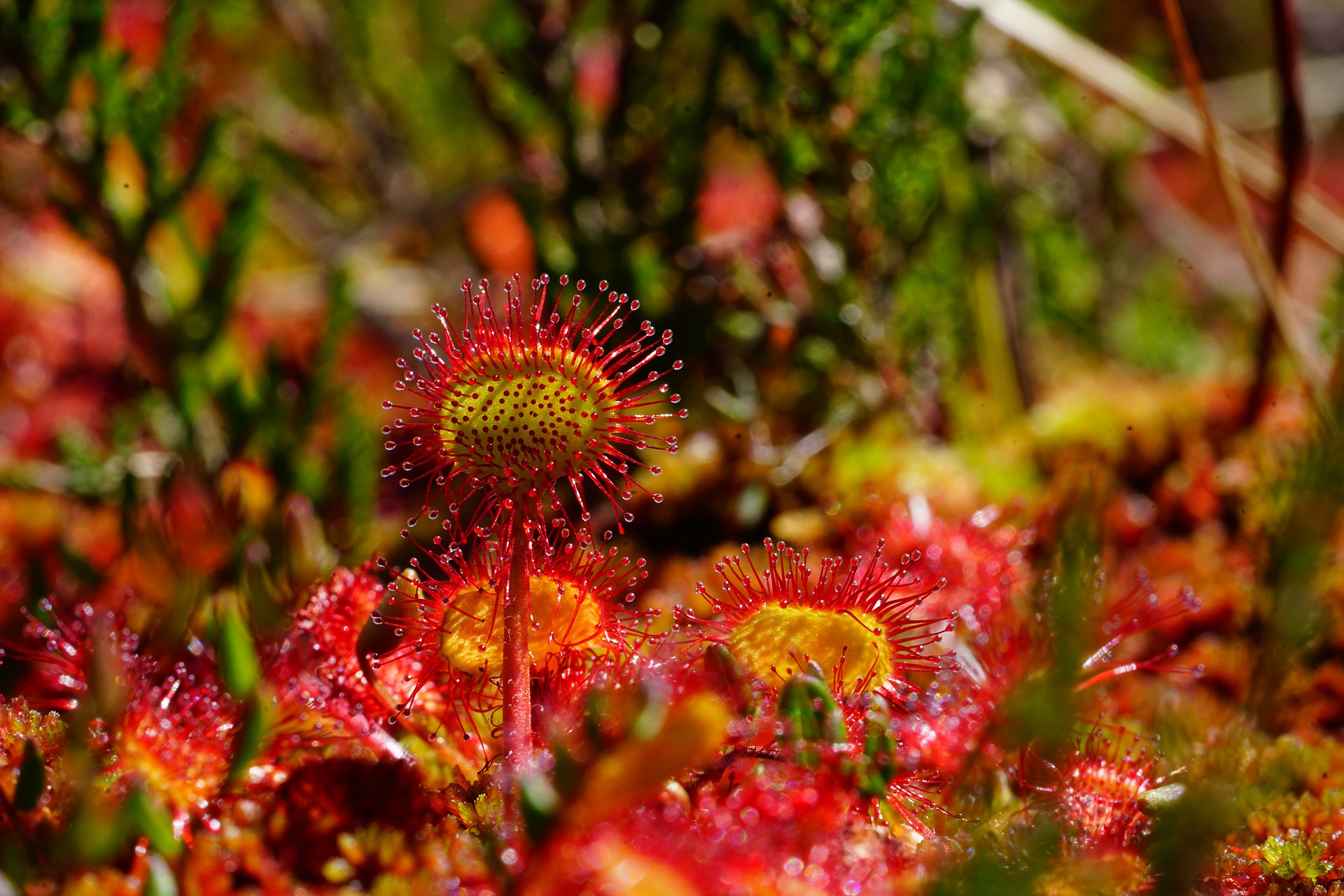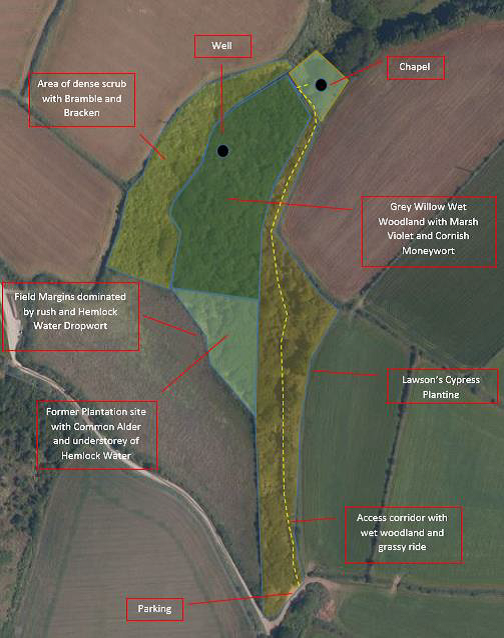 As part of the investigations into the Well Moor area to support the work with the Medieval Chapel and Holy well, a study of the habitat of the area and how this might have changed over time was undertaken. The area today is a wet woodland landscape running along the low part of the land around the stream and leats that run between the chapel and well and then on to Madron.
As part of the investigations into the Well Moor area to support the work with the Medieval Chapel and Holy well, a study of the habitat of the area and how this might have changed over time was undertaken. The area today is a wet woodland landscape running along the low part of the land around the stream and leats that run between the chapel and well and then on to Madron.
In 1840 when the tithe mapping was produced and land characteristics recorded in fair detail the area was known as a ‘morass’, or rough grazing land with some furze (gorse). Historically, this area known as Well Moor was much more of an open place with seasonal grazing and a strong water source in the spring there that we now know as the holy well of St Madern. Written accounts have it as being a summer run for bullocks with open access to the leat and shelter from overhanging (gorse?) bushes, elsewhere in historical accounts soft grass and chamomile are noted as are rushes, which were also recorded as being used for the making of offerings to be placed in the well.
In this excerpt from the desk based assessment carried out by Cornwall Archaeology Unit we have the following fascinating story which hints at a once much more diverse wetland habitat:
"The Penzance Natural-history and Antiquarian Society recorded further details of the vegetation in the boggier places, and recalled a remarkable connection with the studies of the famous naturalist Charles Darwin (1809-1892). The occasion for this was the Society’s excursion to the Well in 1888. Mr Glasson found sundew plants to show the group, and an ex-president of the Society Mr John Ralfs explained that specimens ‘from this very locality’ had gone to ‘the great Darwin’. Drawing attention to the very clammy little ‘frying pan’ shaped leaves with ‘long, gland-tipped hairs, called by Darwin tentacles’ where insects were retained until killed, Ralfs said ‘Mr Darwin was doubtful whether the insects were brought to the leaf by accident.’ He also showed them the Butterwort, another insect eater, and concluded ‘All Mr Darwin’s experiments on this plant were on specimens sent from Penzance." (Applause)’ (Cornishman August 9th 1888, 3). (Image top right: Round-leaved Sundew of type seen around Madron Well, by Hans Baxmeier from Pixabay).
So in all, historically, well moor and its sites seems to have been a much more open, diverse and seasonally grazed wetland area as opposed to the heavily wooded site it is today. (Although the conifers planted to the south of the chapel do appear to be the straggling remains of a plantation put up in the 1800’s some time by one Barnaby Lloyd, after whom the grove was named, at a time when formal landscape planting was more popular.)
The current habitat as it stands today is the result of semi natural regeneration, the ‘morass’ gradually consolidating into a largely self-sown woodland after grazing ceased some-time in the 20th century.
 A habitat survey was commissioned to look at what sort of species make up this wet woodland, an unusual habitat for West Penwith and whether any of the original moorland plants were still present under the trees. Atwell Associates carried out our survey and this excerpt from the summary gives a broad overview of the findings (see also image right showing main habitat areas):
A habitat survey was commissioned to look at what sort of species make up this wet woodland, an unusual habitat for West Penwith and whether any of the original moorland plants were still present under the trees. Atwell Associates carried out our survey and this excerpt from the summary gives a broad overview of the findings (see also image right showing main habitat areas):
"Interpretation of the survey results suggest that this area is a long standing wetland community that until comparatively recently was managed for ‘summering’ livestock. The dominant plant communities hint at a degree of nutrient enrichment and the species list indicated the loss of some of key indicator species of good quality wetland. In particular, historical references from the 1880’s of Sundew and Pale Butterwort suggest that there has been a decline in both species diversity and open habitat probably due to a cessation in grazing. This has been replaced by the development of a wet woodland dominated by Grey Willow alongside a slightly drier area of largely impenetrable scrub, Bramble and Bracken. Only a few indicators suggest a link to a more diverse community in the form of Marsh Violet and Cornish Moneywort. The former once lost from a site rarely returns suggesting it is a representative and persistent element of a once much richer flora.
"The site retains its hydrological integrity and is clearly very wet with water rising from the well and flowing towards the chapel. Based on the evidence provided by the botanical survey it’s hard to determine if the hydrology is changing but clearly the habitat appears to have morphed from 19th century summer cattle grazed wetland (with a scrub / wet woodland element) to a predominantly wet woodland. The development of a closed canopy and the lack of active management has resulted in the loss of a more diverse wetland community to one that appears to be in transition. This process may well have been impacted by nutrient enrichment over a longer period of time associated with adjacent agricultural activity.
 There are records of the water here rising and falling annually as the area gets drier in the summer months and wetter over winter; historical records mention that water generally stopped flowing into the chapel over summer and that is still the case today. During heavy rainfall, runoff from the surrounding land can be seen as rushing rivulets pouring into the wet area any way they can adding to the water issuing forth from the spring itself and keeping the area wet.
There are records of the water here rising and falling annually as the area gets drier in the summer months and wetter over winter; historical records mention that water generally stopped flowing into the chapel over summer and that is still the case today. During heavy rainfall, runoff from the surrounding land can be seen as rushing rivulets pouring into the wet area any way they can adding to the water issuing forth from the spring itself and keeping the area wet.
Luckily the sites themselves remain in relatively good condition despite the changing habitat surrounding them. The cessation of grazing in the 20th century is a common story all over Penwith with once managed land becoming overgrown and ‘scrubbed up’ giving the impression of a much wilder place than it might once have looked like.
The sites and their paths are currently kept clear of vegetation largely by voluntary organisations who have a passion for the sites themselves. This clearing work can be done in such a was as to benefit the habitat as it now stands as well, allowing a few more open areas to develop in the wooded area along the footpath corridor. I’m not sure if we will ever welcome Sundews back onto Well Moor but maybe we can help the surviving wetland plants to thrive a bit more under their woody canopy.
Right - four images of plants around Madron Well (c) David Atwell, 2022:
- Top Left: Himalayan Knotweed alongside the access route.
- Top Right: Pendulous Sedge is ‘frequent’ in the wet woodland.
- Bottom LeftL Arum Lily at the holy well.
- Bottom Right: Running water in the wet woodland where Lesser Spearwort listed in England as ‘threatened’ was found ‘occasionally’.



